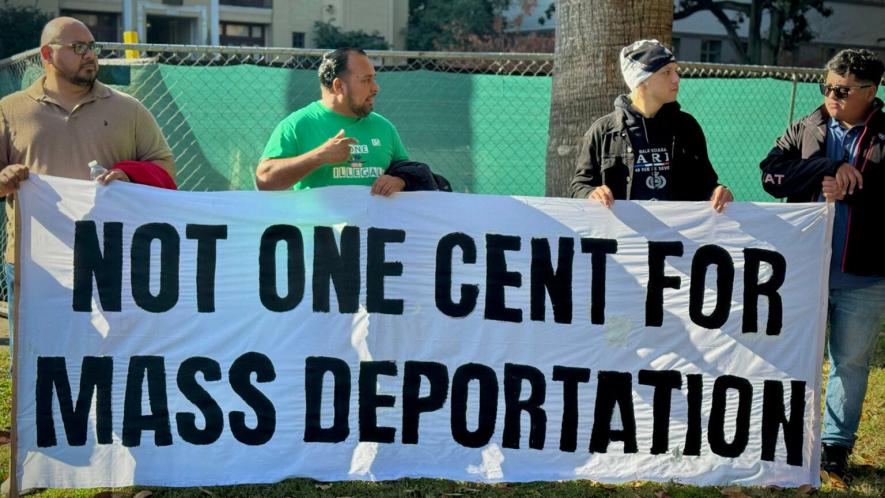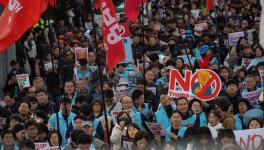How Does Trump Plan to Carry Out Mass Deportations?

Immigrants in California protest in early December (Photo: NDLON)
US President-elect Donald Trump has pledged that on “day one” of his presidency, he will launch the largest program of mass deportations in US history. Trump has promised to expel between 15 to 20 million people. According to the Pew Research Center, there were around 11 million unauthorized immigrants living in the US in 2022—and Trump promises to deport nearly twice that number. Many worry that Trump’s promises of expulsions on such a mass scale would see millions of immigrants, with or without documents, kicked out of the country each year.
How will Trump unleash mass deportations?
“Getting them out will be a bloody story,” Trump threatened at a September campaign rally. Trump has promised to deport not only those he labels as “criminals,” but also “people outside of criminals,” as he said during a “Meet the Press” interview, in which he elaborated neither on which crimes he was including nor what exactly he meant by those “outside of criminals.” Trump as well as those closest to him have promised to radically change a variety of immigration agencies, policies, and programs within the country in order to make his draconian mass deportation plans possible.
“Trump will unleash the vast arsenal of federal powers to implement the most spectacular migration crackdown,” Stephen Miller, responsible for some of Trump’s most racist anti-immigrant policies in his first term, told the New York Times in an interview in November of 2023. Miller is set to serve as Trump’s homeland security advisor and deputy chief of staff for policy in his second term. Miller told the Times that Trump would attempt to end the Deferred Action for Childhood Arrivals (DACA) program, a program secured during Barack Obama’s administration through mass struggle by immigrant youth who entered the country as children, called “dreamers.” The DACA program allows some immigrants who on June 15 of 2012 were physically present in the US and had entered the country as children to avoid deportation.
He also will seek to limit immigration by invoking Title 42, which was used to expel migrants during the pandemic by framing immigration as a threat to public health. The incoming administration will address its infrastructural capacity deficit by building “vast holding facilities that would function as staging centers,” essentially camps, for migrants awaiting deportation. Trump’s team has announced that these vastly expanded migrant detention centers will be located outside major cities with large migrant populations.
Trump also has said he will use the Alien Enemies Act of 1789, one of the oldest laws on the books in the United States, which was intended to allow the president to deport non-citizens considered “enemies” of the US during wartime. “I will invoke the Alien Enemies Act of 1798 to target and dismantle every migrant criminal network operating on American soil,” said Trump at a campaign rally in California. Trump has promised to use the act to initiate an effort he calls “Operation Aurora,” after the Colorado town that many on the right-wing claim is being taken over by Venezuelan gangs, despite Aurora city officials and residents disputing this claim.
Trump has also said he would end birthright citizenship, which has been enshrined in the 14th Amendment to the US Constitution for over a century. The 14th Amendment states that “All persons born or naturalized in the United States, and subject to the jurisdiction thereof, are citizens of the United States and of the State wherein they reside.” Trump has claimed that children of so-called “illegal” immigrants should not be granted citizenship, although any attempts to repeal birthright citizenship could be subject to Supreme Court challenge.
Trump’s incoming administration could also target sanctuary cities and states, in which city and state officials within more left-leaning areas have pledged to resist federal attempts at mass deportations. In such “sanctuary” jurisdictions, local officials or governors declare that they will limit or deny their cooperation with federal immigration enforcement efforts. The city of Los Angeles, for example, passed an ordinance that bars the collection or sharing of a person’s immigration status in relation to carrying out immigration related arrest or deportation—with the new exception in the investigation, arrest, and detention of immigrants previously convicted of aggravated felonies. Some states, such as Tennessee, Iowa, and California, have enacted legislation related to their sanctuary policies.
States that have promised to push back against Trump’s second term plans include California, Illinois, New Mexico, and Arizona. California Attorney General Rob Bonta has said, for example, that his office is preparing for “a full frontal assault on our immigrant communities.”
“We are ready to file,” Bonta said, referring to a potential lawsuit challenging Trump’s immigration policy. “We have been thinking about and preparing and readying ourselves for the possibility of this moment for months,” Bonta said about the incoming Trump administration.
During his first term, Trump targeted cities that refused to cooperate with federal anti-migrant efforts during his first term, including New York City, Chicago, and Seattle. For his second term, Trump and his incoming administration have floated the possibilities of withholding funds from sanctuary cities as well as prosecuting those who attempt to impede federal immigration enforcement. Trump’s appointed “border tsar” Thomas Homan (who was given a Presidential Rank Award by Barack Obama for his successful regime of deportations under the former Democratic president) has pledged to slash federal funding to states who choose not to cooperate with Trump’s deportation plans.
Mass deportations could hurt all workers
Mass deportations and anti-immigrant policies have been framed by Trump and the Republican Party as good for US-born workers. The Republican Party platform’s promise to “seal the border” and “stop the migrant invasion” ends with a promise to “put American Workers first.”
However, research has found that mass deportations could hurt US-born and immigrant workers alike. Because immigrant workers are often the most exploited in the US economy, they tend to take the most dangerous and low-paying jobs in a given industry, which are essential to keep certain businesses running and in turn create the most attractive jobs that US-born workers tend to take. The contribution of immigrant workers to the household service industry makes it easier for many US-born workers who hire them to work outside of the home. Almost 6% of unauthorized immigrants are housekeepers, construction workers, and cooks, as compared to 2% of authorized immigrant workers and 1% of US-born workers.
Immigrant workers also contribute to local demand for goods and services.
Rhetoric against immigrant workers often claims that they do not pay taxes and are otherwise a drain on public resources. However, data shows that the opposite is true: a study by the National Academies of Sciences, Engineering, and Medicine found that in a given year, someone born outside of the US and their dependents pay on average USD 1,300 more in federal taxes than they receive in federal benefits. Additionally, immigrants in their lifetime pay USD 237,000 more in taxes than they receive in benefits from federal, state, and local governments.
Immigrant workers fight back
Despite facing draconian threats to their communities, immigrant workers remain determined to fight back. Some organizers, such as those affiliated with the National Day Laborer Organizing Network (NDLON), have promoted slogans such as “solo el pueblo salva al pueblo” (only the people will save the people).
According to Marco Castillo, the board president of Red de Pueblos Transnacionales, a grassroots network of immigrant groups in New York City, “I don’t think we’re going to be seeing big visible collaborations [between migrant communities and] local authorities, and this is because seems like the Trump administration has been able to bend many local authorities in his favor under the promise of funds.”
As a result, Castillo predicts that immigrant communities organizing to face mass deportations will need to turn to each other. “Communities will organize among peers, and in our case, Indigenous immigrant communities will organize with other Indigenous immigrant communities to protect their own neighborhoods, and to monitor the presence of ICE or other federal agencies, as well as to identify allies in our communities that can support us in preventing and reacting.”
Castillo, who has organized with Indigenous and rural communities in Mexico, Central America, and the US for over 21 years, also highlights the necessity of communities of immigrant workers banding together with US-born workers. According to Castillo, both US-born and immigrant workers “need to see that we are in the same situation, and a threat to immigrants is a threat to all the working class.”
“We need to see beyond this anti-immigrant rhetoric that it’s just intending to divide us under the idea that immigrants are taking jobs from non-immigrants,” Castillo said. “In reality, the US is displacing people from communities in the [Global] South that would much rather stay and be workers in their own communities. Just like folks in the US.”
Get the latest reports & analysis with people's perspective on Protests, movements & deep analytical videos, discussions of the current affairs in your Telegram app. Subscribe to NewsClick's Telegram channel & get Real-Time updates on stories, as they get published on our website.
























